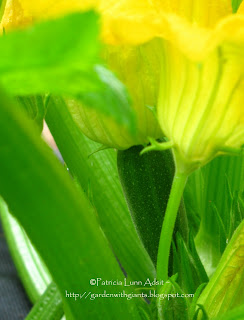See what you can see in this picture, taken on the morning after our return home.
 |
| It's a jungle out there! |
Looking from the Box Garden (raised beds) back toward the southwest, you can see how some of the tomatoes have outgrown their cages...and almost over-topping their stakes. The really tall ones you are looking at about center of the shot are German Johnsons, an Open-pollinated (AKA: "Heirloom") variety that is particularly happy here this year. In the right foreground, you are seeing the Fordhook Lima beans, growing up nicely in the box garden. Between the limas and the tomatoes, you can see the okra on the rise in the black fabric-covered row. And, off to the left, between the tomatoes and the fence and shed, you can see the daylilies in bloom.
Here are some of our daylilies, currently in bloom:
 |
| Elvis' Cape (and Abbie near Enon) |
 |
| Alabama Jubilee |
 |
| Joe Marinello |
 |
| Persian Peach |
 |
| Purple Pinwheel |
 |
| Red Ribbons |
No, I don't necessarily remember all of their names. I do need to look them up on occasion. Especially since we missed most of their blooms last year due to our extended stay in KY. Ah well, it's good to get reacquainted, don't you think?
Daylilies really bring the pollinators (bees and other beneficials) into the Way Back, which is good because most members of the cucurbit family are in bloom: the cucumbers (on a lattice-work trellis*), the yellow crookneck squash, the zucchini, and the watermelons (Sugar Baby and Crimson Sweet). The pumpkins and the muskmelons (which we persist in calling cantaloupes...:-) are not yet blooming...but that shouldn't be too much longer at the rate they are growing.
 |
| Crookneck Squash |
 |
| Crimson Sweet Watermelon |
 |
| Straight Eight Cucumbers on trellis |
Now, all is not a bed of roses around the Kitchen Garden, sad to say. While we were away, the squash bugs came out to play...and lay eggs. Yuck. While I had kept them at bay for the early days of the vulnerable plants with row covers, when the cucurbits started to flower I had to remove the covers to give access to the pollinators, so they could do their part in giving us a good harvest. Upon my return, I was doing my due diligence in pest management when I noticed a few leaves that looked like this picture:
 |
| Where's my water bucket? |
If you follow that link on squash bugs to the Organic Gardening site, you will learn that "they" recommend squashing the squash bugs on the leaf. My method is to cut the leaf off and dunk it in a pail of water. You see, I have a habit of tasting my harvest, straight off the vine...and I really don't want to think about having bug-egg guts on my gloves...or worse yet, on my fingers and under my nails. Personal preference.
Speaking of tasting...
 |
| Sun Gold tomatoes |
Yes, the daylilies and the Kitchen Garden have been particularly productive while we were away, as has the Berry Patch. I was so excited to get a cup of blackberries and nearly 2 cups of blueberries. My recipe for blueberry pie calls for 4 cups...and if I can stop eating the ones I've harvested, I hope to have enough to start baking this weekend.
If only I can stop eating the ones I've already harvested...
 |
| Blueberries! |
Happy hoeing!




















